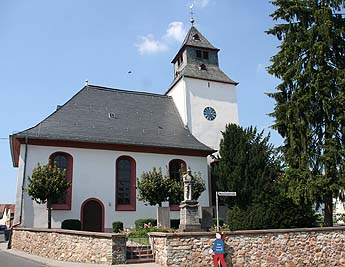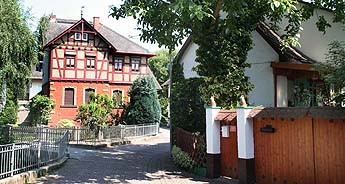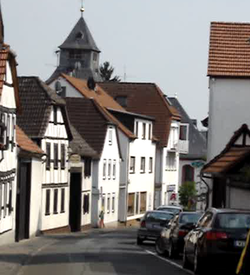Wiesbaden-Breckenheim
Breckenheim is a local district of the Hessian capital Wiesbaden. It was incorporated on 1 January 1977 in the framework of municipal reform in Hesse in Wiesbaden and has about 3,400 inhabitants.
Breckenheim is located near the Federal Highway 3, near the Wiesbaden Cross and borders Wallau (district of Hofheim am Taunus ), and the Wiesbaden Districts Medenbach, Igstadt and north of the city.
History
The first documentary mention as breaking Home is located in a donation from May 1 950 by King Otto I to the Earl Gerung (country in Königssundrandgau ( Königssondergau ) in Breckenheim, Wallau and north of the city ). The discovery of a Frankish burial ground dating from the 6th century in the north city suggests a Frankish settlement in this time here in Breckenheim. After presentation by Dr. phil. Hensche (home book " The former district of Wiesbaden " ), it is conceivable that this settlement due to their clan leader " Brecko " got its name. "Home" probably indicates a larger settlement through ( 6th to 9th centuries).
In the 12th century the rule of Eppstein was the owner of the place Breckenheim. On May 15, 1251, the Archbishop of Mainz donated to the cathedral chapter of Mainz goods in Breckenheim and heritage home. A miller named Engilbertus found in the deed mentioned.
The Breckenheimer church is first mentioned 1280-1285 as a branch church of Wallau. 1310 a separate parish is erected. The priest was sent off Bleidenstadt monastery.
In 1492 became part of the dominion Eppstein areas, including the village Breckenheim, for 64,000 guilders by Gottfried X. to the Landgrave Wilhelm III. sold by Hesse.
During the Thirty Years' War, the village including the church, parish and school house was heavily damaged.
1718 to 1724 a school house was built, the last served as the town hall until 1966 and was then demolished. The church was then in its present form. After Reichsdeputationshauptschluss Breckenheim came in 1803 to the Principality of Nassau- Usingen. With the establishment of the Office Hochheim am April 4, 1816 Breckenheim belonged to this Duke of Nassau office. With the annexation by Prussia Nassau Breckenheim 1866 Prussian and part of the main circuit.
1845 the road to Igstadt was developed as a road.
1928 Breckenheim received a first water pipe. 1936, a new school was built. From 1936-39, the construction put on the present Federal Highway 3 through the district. With the paving of local roads was started 1953/55, sewers were laid in 1963-65.
From 1965 began a building boom. First, the town hall and fire station were built as a multipurpose building, and came before the city hall then a children's playground. In 1968 the construction of a cemetery chapel. 1971-74 new housing estates were developed, built the sports and cultural hall and the kindergarten in the Fountain Street. In 1974, the old village square has been redesigned.
In the course of municipal reform in Hesse Breckenheim lost its municipal autonomy. The place was spun off from the Main -Taunus district and incorporated as a district in the city of Wiesbaden. For Breckenheim a local district with town council and mayor was set up as for all the churches formerly independent.
Since 1998 there was again a large construction site in the district. Parallel to the highway was the ICE line between Cologne and Frankfurt with the tunnel Breckenheim.
2007, the new village square after considerable self-initiative of the inhabitants was completed.









